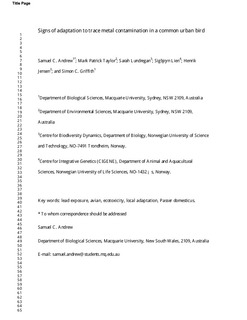| dc.contributor.author | Andrew, Samuel C. | |
| dc.contributor.author | Taylor, Mark Patrick | |
| dc.contributor.author | Lundregan, Sarah | |
| dc.contributor.author | Lien, Sigbjørn | |
| dc.contributor.author | Jensen, Henrik | |
| dc.contributor.author | Griffith, Simon C. | |
| dc.date.accessioned | 2019-04-26T09:07:28Z | |
| dc.date.available | 2019-04-26T09:07:28Z | |
| dc.date.created | 2018-09-04T12:57:32Z | |
| dc.date.issued | 2018 | |
| dc.identifier.citation | Science of the Total Environment. 2018, 650 679-686. | nb_NO |
| dc.identifier.issn | 0048-9697 | |
| dc.identifier.uri | http://hdl.handle.net/11250/2595647 | |
| dc.description.abstract | Metals and metalloids at elevated concentrations can be toxic to both humans and wildlife. In particular, lead exposure can act as a stressor to wildlife and cause negative effects on fitness. Any ability to adapt to stress caused by the negative effects of trace metal exposure would be beneficial for species living in contaminated environments. However, mechanisms for responding adaptively to metal contamination are not fully understood in free-living organisms. The Australian populations of the house sparrow (Passer domesticus) provides an excellent opportunity to study potential adaptation to environmental lead contamination because they have a commensal relationship with humans and are distributed broadly across Australian settlements including many long-term mining and smelting communities. To examine the potential for an evolutionary response to long-term lead exposure, we collected genomic SNP data using the house sparrow 200 K SNP array, from 11 localities across the Australian distribution including two mining sites (Broken Hill and Mount Isa, which are two genetically independent populations) that have well-established elevated levels of lead contamination as well as trace metals and metalloids. We contrast these known contaminated locations to other lesser-contaminated environments. Using an ecological association genome scan method to identify genomic differentiation associated with estimates of lead contamination we identified 60 outlier loci across three tests. A total of 39 genes were found to be physically linked (within 20 kbps) of all outliers in the house sparrow reference genome. The linked candidate genes included 12 genes relevant to lead exposure, such as two metal transporters that can transport metals including lead and zinc across cell membranes. These candidate genes provide targets for follow up experiments comparing resilience to lead exposure between populations exposed to varied levels of lead contamination. | nb_NO |
| dc.language.iso | eng | nb_NO |
| dc.publisher | Elsevier | nb_NO |
| dc.title | Signs of adaptation to trace metal contamination in a common urban bird | nb_NO |
| dc.type | Journal article | nb_NO |
| dc.type | Peer reviewed | nb_NO |
| dc.description.version | acceptedVersion | nb_NO |
| dc.source.pagenumber | 679-686 | nb_NO |
| dc.source.volume | 650 | nb_NO |
| dc.source.journal | Science of the Total Environment | nb_NO |
| dc.identifier.doi | 10.1016/j.scitotenv.2018.09.052 | |
| dc.identifier.cristin | 1606587 | |
| dc.relation.project | Norges forskningsråd: 221956 | nb_NO |
| dc.relation.project | Norges forskningsråd: 223257 | nb_NO |
| dc.description.localcode | Publisher embargo until Febuary 10, 2021 (c) This manuscript version is made available under the CC-BY-NC-ND 4.0 license http://creativecommons.org/licenses/by-nc-nd/4.0/ | nb_NO |
| cristin.unitcode | 194,66,10,0 | |
| cristin.unitname | Institutt for biologi | |
| cristin.ispublished | true | |
| cristin.fulltext | accepted | |
| cristin.qualitycode | 2 | |
